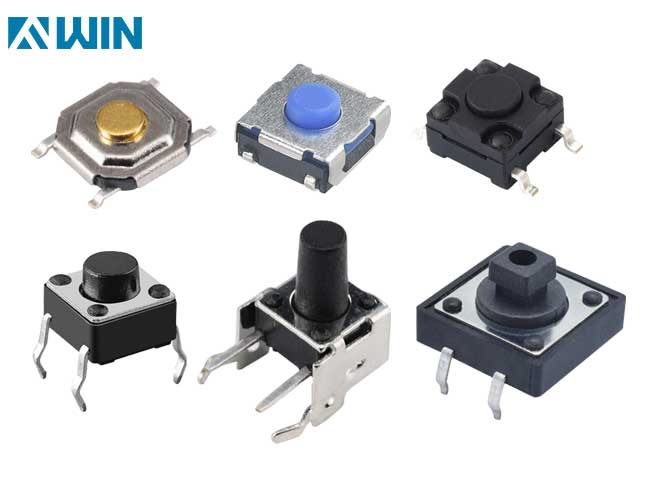KNOWLEDGE
A Complete Guide to Momentary tact Switches
Momentary tactile switches, also known as momentary pushbutton switches, are essential components widely used in electronic devices and systems. These switches are designed to remain in their activated state only as long as they are being pressed. Once released, they return to their original position. This guide will cover the fundamental features, working principles, applications, advantages, and selection considerations for momentary tactile switches.

What are Momentary Tactile Switches?
Momentary tactile switches are simple, small mechanical devices that complete or break an electrical circuit when pressed. The defining feature of a momentary switch is that it does not stay in the activated position once released. These switches can be either normally open (NO), where the circuit is open until the button is pressed, or normally closed (NC), where the circuit is closed and opens when pressed. They are often used for initiating a short action, such as resetting a system or turning a light on or off.
Key Features of Momentary Tactile Switches
Small Size:
Momentary tactile switches are typically compact, making them ideal for use in small or portable devices where space is limited.Low Actuation Force:
These switches often require minimal pressure to operate, providing a comfortable user experience. This is particularly important in handheld devices like remote controls and mobile phones.Tactile Feedback:
A momentary tactile switch provides clear feedback through a physical click or a tactile sensation when pressed, confirming that the action has been registered. This feedback enhances the user experience, ensuring the switch has been activated.Variety of Contact Configurations:
Momentary switches come in different configurations such as single-pole single-throw (SPST), single-pole double-throw (SPDT), and double-pole double-throw (DPDT), providing flexibility in switching applications.Illumination Options:
Many momentary tactile switches come with built-in LEDs for visual feedback, making them suitable for low-light environments or applications where visual confirmation is necessary.Durability:
Despite their small size, momentary tactile switches are designed for high durability, capable of enduring thousands of cycles before showing signs of wear.
Working Principle of Momentary Tactile Switches
The working principle of a momentary tactile switch is straightforward. When the button is pressed, it temporarily connects two electrical contacts, completing the circuit and allowing current to flow. Once the switch is released, a spring or mechanism returns it to its default position, opening the circuit again. This process is typically fast and responsive, making these switches ideal for applications where short, discrete actions are required.
Applications of Momentary Tactile Switches
Momentary tactile switches are used in a wide range of applications, including:
Consumer Electronics:
Momentary switches are commonly used in products like remote controls, calculators, gaming controllers, and digital cameras. Their compact size and tactile feedback make them ideal for these devices.Industrial Equipment:
In industrial settings, momentary tactile switches are used in control panels, machinery, and alarm systems. They can trigger specific actions, such as starting a machine or initiating a safety shutdown.Medical Devices:
In medical equipment, where precision and reliability are crucial, momentary switches are used for actions like resetting devices, controlling alarms, or activating diagnostic functions.Automotive Controls:
Momentary switches can be found in vehicles for functions like horn activation, controlling lights, and starting systems, where a temporary action is required.Home Appliances:
Many home appliances, such as microwaves and dishwashers, use momentary tactile switches for functions like power on/off, mode selection, and cycle changes.
Advantages of Momentary Tactile Switches
Space-Efficient Design:
The small size of momentary tactile switches makes them suitable for use in applications where space is at a premium.Simple Operation:
Momentary switches are straightforward and easy to operate, requiring minimal user input to perform basic tasks.Reliable Performance:
With high durability and low failure rates, momentary switches are a reliable choice for applications that require repeated activation.Cost-Effective:
Momentary tactile switches are inexpensive, making them a cost-effective solution for many different types of devices, from consumer electronics to industrial machinery.User-Friendly Feedback:
The tactile feedback provided by these switches ensures users know when the switch has been successfully activated, reducing operational errors.
How to Choose the Right Momentary Tactile Switch
When selecting the appropriate momentary tactile switch for your application, consider the following factors:
Actuation Force:
Choose a switch with an actuation force that is comfortable for the user. Too much force can make the switch difficult to press, while too little can lead to accidental activations.Size and Mounting Style:
Ensure the switch fits within the design constraints of your device. Momentary tactile switches are available in various sizes, and the mounting style (e.g., through-hole or surface-mount) must be compatible with your design.Voltage and Current Rating:
The switch should be rated for the voltage and current your circuit will require. Overloading the switch beyond its rating can cause failure.Contact Configuration:
Depending on your system, you may need a switch with different contact configurations, such as SPST or SPDT, to achieve the desired switching functionality.Illumination Needs:
If the switch needs to be visible in low-light environments, choose an illuminated momentary tactile switch with LED options.
Conclusion
Momentary tactile switches are indispensable in modern electronics, offering reliability, simplicity, and ease of use in a variety of applications. Their small size, low actuation force, and tactile feedback make them suitable for everything from consumer electronics to industrial machinery. By understanding their key features and considering factors such as actuation force, electrical ratings, and environmental needs, you can choose the perfect
Column navigation
NEWS
CONTACT ME
CONTACT:
Skype:evelynhwang2013
phone:15999819066
E-mail:fvwin@fvwin.com
ADD:NO.168,Technology East Road,Shijie Town,Dongguan,GD,CN